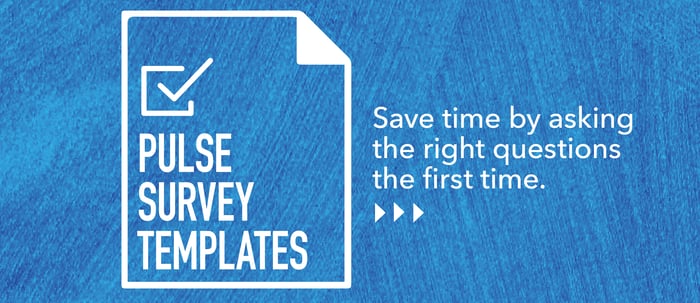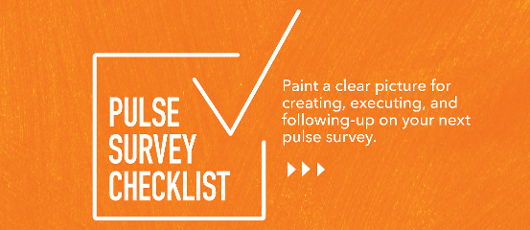Employee Pulse Survey Best Practices for Collecting Real-Time Feedback
Employee engagement has been the driving force behind people success for organizations around the world. Some companies are spending millions of dollars each year trying to transform their workplaces into ones that attract top talent, achieve high productivity, and keep top performers for a lifetime.
HR has traditionally utilized annual engagement surveys to measure, understand, and improve employee engagement. These surveys are still effective for getting a comprehensive picture of an organization’s overall employee engagement. But in our fast-paced society, a lot can change in a year. You need to include more frequent employee surveys into your employee listening strategy.
Enter the employee pulse survey. These frequent, fast, and efficient surveys take just a few minutes to complete and can provide real-time, actionable feedback and insights for your team managers and senior leaders.

Pulse surveys allow you to capture employee feedback when it matters most. In this section we’ll discuss:
- What pulse surveys are
- What pulse surveys aren’t
- Why you should use them
What is a pulse survey?
A pulse survey is an easy-to-implement survey designed to strategically collect employee opinions about important workplace topics in a time-efficient manner. It’s a way to follow up on key discoveries from an annual engagement survey or receive quick feedback on strategic workplace initiatives. Here are 8 key factors of a pulse survey:
1. Pulse surveys are short.
Just as they sound, pulse surveys are meant to quickly check on employee perceptions about an issue or idea. Keeping the survey limited to a few specific and targeted questions will increase the chances of employees completing it.
2. Pulse surveys are simple.
Pulse surveys should be easy to build, launch, and complete. While the framework of a pulse survey is simple, the data you collect can be complex. Pulse surveys should be focused enough to answer a specific question and simple enough to capture the information you are looking for.
3. Pulse surveys are flexible.
No matter the intent, pulse surveys can suit your needs. This shift is one that has made pulse surveys so popular over the last few years. Annual engagement surveys are usually focused on understanding the drivers of engagement within an organization. Pulse surveys can vary by topic, frequency, length, audience, and more.
4. Pulse surveys can be targeted.
Engagement surveys are used to gather feedback from your entire organization. When covering a broad range of topics and demographic data it can take a lot of time and effort to sift through and surface valuable insights. Pulse surveys allow you to collect feedback from a specific group of employees so you can take strategic action at a local level – such as surveying selected team leaders about their hiring needs for the upcoming year.
5. Pulse surveys can be a research tool.
The workplace can be a complex environment and understanding the ins and outs of your employee experience can be challenging. Pulse surveys can be used to effectively evaluate your people success programs and initiatives. For instance, you can pulse about your onboarding program or pulse to evaluate the effectiveness of your learning initiatives.
6. Pulse surveys do not replace annual engagement surveys.
Pulses can be used to follow up on your annual engagement survey. But they shouldn’t replace your company-wide survey, which is critical for looking at trends and themes over time that speak to the bigger picture of your engagement strategy. Pulse surveys give you real-time, actionable data to use between your engagement surveys.
7. Pulse surveys should be a strategic part of your employee listening strategy.
From annual engagement surveys to lifecycle surveys, pulse surveys tend to be the “cool kid” of survey tools. But they should also be a strategic part of your employee listening strategy. You can use them to collect fun ideas and opinions – however, most should be connected with your people success strategies.
8. Pulse surveys don’t have to be owned by HR.
Employee surveys are usually designed, communicated, and launched by HR. But, with some guidance and coaching from HR, other organizational leaders can use pulse surveys. Pulse surveys are great resources for collecting feedback about job alignment or candidate experience. Tracking this data over time can help you gain further insight into what’s going well and any opportunities for growth.
The benefits of pulse surveys
Pulse surveys allow you to collect data more frequently than annual engagement surveys. But beyond that, pulse surveys have many benefits that can improve employee, team, and business success. Pulse surveys can help you:
- Increase communication and transparency
- Build trust
- Improve culture
- Collect real-time feedback
- Inform and enable smarter decisions
Increase communication and transparency.
Pulse surveys help businesses improve communication by encouraging employees to speak up. When you share results (and take action on them), you show employees that you value their opinions and that their feedback impacts your decisions.
Build trust.
Employees want to know their voices are heard—so it’s important to do your research and find out how employees feel before and after an important initiative. Pulse surveys encourage employees to share their opinions, influence their support, and ultimately build trust.
Improve culture.
Culture is a difficult thing to measure, and when employees are disengaged, they aren’t always open to sharing their opinion publicly. Pulse surveys allow you to uncover and respond to your organization’s “hidden truths” so you can keep working toward a healthy culture.
Collect real-time feedback.
Pulses allow you to gather employee opinions when it matters most—in real-time. Instead of waiting until the end of the year to gather employee opinions on a topic, you can capture feelings and thoughts as they happen. This sets you up to respond in a timely, relevant manner.
Inform and enable smarter decisions.
If you’re curious about how your employees are feeling about an issue in your office, sending a pulse survey can help squash pre-conceived notions and elevate the truth. The results will help you create action steps to inform, shape, and improve your plans.
Developing your pulse survey strategy
Creating a pulse survey strategy that fits your organization’s needs involves a few steps before you launch. In this section, we’ll break down the five overarching steps for developing your pulse survey strategy:
- Define your purpose
- Set objectives
- Choose the right audience
- Establish a frequency
- Create a follow-up plan
1. Define your purpose.
Before you start question selection and survey design, it’s important to clearly define your purpose. Having a clear picture of what you want to accomplish can help you choose the right scope of topics, questions, audience, and timeline. Get really specific and find out:
- What purpose does the survey serve?
- What information do I want or need?
- Can this information be collected without a survey?
Answering these questions allows you to get really specific about the outcomes of your survey and will drive your design strategy.
2. Set objectives.
It’s easy to create pulse surveys and send them out, which means it’s easy to create surveys that may not be strategic in nature. If you launch a pulse without a clear purpose, you’ll get results that don’t really answer the question you have.
Before designing your pulse survey, no matter how big or small it may be, it’s important to understand what you want from the process:
- What do you want to measure?
- How will the results be used?
- What needs to be asked so that you can take action afterwards?
Build your objective with key results in mind. These outcomes are what will fuel your survey initiatives and also help you evaluate the results once the survey has closed.
3. Choose the right audience.
Once you’ve defined your purpose, you need to determine who to survey. Depending on the topic, you may want to survey your entire company, while more specific or informal topics may only affect a small group of employees.
Answer these questions when choosing your audience:
Should the survey be anonymous or attributed?
Some pulse survey topics require anonymity, while others require more transparency. Putting a name to critical feedback may increase anxiety and decrease honesty in the data collected. But as culture improves, employees will more readily offer authentic feedback with their name attached.
Should you survey the entire population?
Pulse surveys are great for collecting quick feedback from small groups of people, and you should only survey your entire company when the topic is relevant to all employees. Start with a focus group to gain insight about the questions you want to ask before rolling it out to the entire organization.
Does this survey impact a specific department or team?
Feedback is often only needed from a distinct group, such as a department, location, or team. These surveys are intended to create a better understanding of a topic that is more localized or relevant to a specific group.
Does this survey impact unique demographics?
It can be beneficial to check in with specific demographics within your workforce to understand how their perspective differs from others. Consider how generation, tenure, gender, employment type, and location might impact your survey questions.
4. Establish a frequency.
The golden rule of conducting a pulse survey is to only gather feedback as often as you are able to act on it. Employee response rates increase when action is taken based on survey results—and they decline when no change takes place. And while pulse surveys are quick, and easy to deploy, it doesn’t mean you should survey employees as often as you want.
Your pulse survey frequency should take into consideration all of the other listening posts your organization is using. Set a rule that makes sense for your workforce and stick to it. Too many surveys can become distracting and fatigue employees.
While there is no surefire formula when it comes to pulse survey timing, there are a few guidelines you can follow to determine the right frequency for your organization.
Pulse on topics that are likely to fluctuate.
It can be hard to capture real-time feedback when new situations arise. Consider sending a pulse survey when there are big changes in the organization that impact every employee, such as a rolling out a new benefits plan.
Only survey as often as your organization can act on feedback.
If you’ve just completed an engagement survey and are still working through the data, you might not have the capacity to collect and take action upon more information. Check in with your managers, senior leaders, and HR team to determine if you have the bandwidth to respond to another survey.
Administer based on your organization’s culture.
Every company operates a little differently than the next. So, your pulse surveys should feel familiar and authentic when your employees receive them. Surveying your employees should feel like a natural part of their workflow.
Complement the timing of your pulse survey to your annual engagement survey.
Get started with pulse surveys by using your annual engagement survey as a marker in your engagement strategy, and pair a pulse as a follow up six months after launch. This will give employees time to reflect on changes made and provide you with honest reactions to your initiatives.
5. Create a follow up plan.
When you take action, your employees can see that you took their feedback into consideration and valued their opinions. Here are six steps to take following your pulse survey:
Communicate the purpose of the survey.
Connect with senior leadership to create a plan for communicating the survey’s purpose with your team. Sharing information about the survey prior to launch lets employees know what to expect and what you’re hoping to learn from the results.
Act on pulse survey results.
If you don't act on employee opinions, your survey may fall flat and leave employees feeling disengaged. Every survey should include an employee communication plan to share results, conclusions, and next steps.
Select areas to improve and areas to celebrate.
Identify where you need to improve and source employee feedback. Involving your employees in the decision-making process empowers them by giving them a voice to help you achieve success.
Make and implement decisions.
Once your team is on the same page for selected areas of improvement, it’s time to act. Break up bigger initiatives into small steps, split ownership of tasks, and conduct small experiments as you begin to implement new changes.
Evaluate and keep moving forward.
Be sure your team has a plan to check in and evaluate progress. If the change isn’t working, adjust or discuss alternatives—if things are going great, move on to another area and start making new improvements.
Make pulse surveys part of your employee engagement strategy.
If you’ve been surveying employees annually, pulse surveys are a great next step. They allow you to collect meaningful information related to specific organizational change or simply keep your finger on the pulse of your organization.
Launching your pulse survey
Pulse surveys are designed to help you gather specific and meaningful data you want and need. This section outlines how to launch an effective pulse survey, including:
- Choosing the right pulse survey questions
- Designing your survey
- Reflecting and getting ready to launch
Choose the right pulse survey questions
With such a small window of opportunity it’s important to select questions that help you collect the data you are looking for. Consider these tips when choosing the right pulse survey questions:
Narrow the focus of your survey questions.
Pulse surveys should center around one or two key topics of interest. Addressing too many in one survey can be overwhelming for respondents.
Limit your pulse survey to 5-15 questions.
The rule of thumb for pulse surveys is 5-15 questions that can be completed in just a few minutes. Remember, less effort to complete = better response rate.
Build your pulse survey questions to collect meaningful data.
To gather data that is more informative and insightful, consider creating questions that are specific, timely, and actionable.
Make sure the response options make sense.
Response options are what respondents interact with when filling out surveys, so it’s important to have a keen eye for detail when determining your selection.
Design your pulse survey, simply.
Pulse surveys are important for gathering useful and reliable data. And the simpler the survey is to take, the more useful the responses.
Avoid long, complicated words.
When writing your survey questions, avoid longer words—this includes any technical jargon that employees might not understand. Shorter words are easier to read and are less mentally taxing on your survey takers.
Shorten the survey question length.
To simplify your survey even more, make sure your survey questions are relatively short. It shouldn’t feel like you have to read a novel or write an essay to answer a survey question.
Adjust the tone.
The tone of your survey questions can also impact responses. Avoid exaggerative or negatively worded questions to eliminate confusion. Instead, try rephrasing negative questions as positive statements and reverse your score.
Find time to reflect and refocus.
Set aside your survey for a period of time to think about other tasks and take a mental break. By waiting a day or two to complete a final read-through, you may catch spelling or punctuation errors you overlooked, or read a question in a different way that now sounds confusing.
This step is critical to identify smaller errors that are easy to miss and allows you to send a survey that’s as polished as it can be. Consider sending to a few other stakeholders to get some feedback on the survey itself before rolling it out to all employees.
How and when to use pulse survey templates
Pulse surveys can serve a variety of purposes. But when you’re strapped for time, resources, and people, it can make sending a quick pulse survey seem like a big project. This is where pulse survey templates come into play.
Using a pulse survey template helps you get the data you need to build an incredible work culture. They provide a baseline for collecting the right data with the flexibility to fit your organization's needs.
Diversity and Inclusion
How to use it: A pulse survey about diversity, equity, and inclusion helps you understand how employees feel about those topics, and whether or not they think their manager or employer supports them. This template asks employees for their point of view and ensures you are engaging everyone.
When to use it: Use a diversity and inclusion pulse survey as a follow up to your company-wide engagement or diversity and inclusion survey. This survey might also be critical as you roll out new D&I learning and development or recruitment initiatives.
Change Management
How to use it: Hearing from employees during or immediately after a change management initiative shows that you are interested in making sure they feel secure and safe despite major change. This template helps you understand and evaluate how employee views and perceptions were impacted.
When to use it: Send a change management pulse survey to collect instant feedback from employees after a company-wide change. This might include a merger or acquisition, layoff, moving to a new location, and more.
Post-Training Event
How to use it: Similar to change management, training and development that impacts a broad group of employees are key opportunities to collect feedback to improve your employee experience. This template helps you understand employee feedback about specific trainings, including effectiveness of materials, facilitator feedback, and overall relevance.
When to use it: No later than a few days after the training event. If you wait too long, employees won’t be able to recall all the details of the event in order to provide you with valuable feedback.
Employee Benefits
How to use it: At the root of employment, employees work to earn a salary and benefits associated with the position. Making sure your employees are satisfied in this area can make or break their engagement as a whole. This template helps you gather information about employee views, understanding, and satisfaction of benefit plan offerings.
When to use it: For new employees, a pulse survey may be helpful in understanding perspectives compared to their initial experience during the recruitment process. Additionally, anytime you make a change to your benefits policy, it’s a good idea to get your employees’ feedback to ensure they understand the change.
What’s next with pulse surveys?
Pulse surveys are relatively new in the workplace, but they’re already making a huge impact in many organizations. As the workplace landscape continues to change, these quick and convenient surveys will be the perfect tool to adapt and grow your business.
Here’s how pulse surveys are evolving the workplace:
They will empower employers who desire to be smarter with their data.
We live in a data-driven world. New software surfaces every day—giving managers and HR leaders the power to collect, aggregate, and analyze employee data in an instant. But understanding this complex information can be challenging. Pulse surveys will help distill this data into bite-size pieces for employers to digest, respond to, and act on quickly and efficiently.
They will support leaders who want and expect feedback.
The modern workforce knows what they want and expects to be coached to get there. And as more Millennials and younger generations enter the workforce, employers will be forced to accommodate their needs. Through ease of use, pulse surveys will give managers at all levels the ability to collect employee feedback in order to make a direct impact on their teams.
They will empower managers to become owners of employee engagement.
A wide range of roles are turning to pulse surveys to measure business impact—including business intelligence teams, product managers, and more. Empowering managers to start adding pulse surveys into their strategic initiatives takes the burden of owning employee engagement off of HR and into the hands of employees.
They will change in frequency and design.
Pulse surveys have certainly evolved over time. HR leaders are debating about what frequency and design is best. When do you ask for feedback? How often? These are considerations that will continue to change with time.
Don’t forget: too much of a good thing can be a bad thing. Weekly surveys aren’t sustainable or insightful over time. When employees receive the same question over and over, they won’t respond as accurately each time. With so many variables at play, it can be difficult to discern how credible that feedback is.
They will encourage collaboration.
Employees want to see that their feedback is heard and acted on. Pulse surveys will help HR leaders do this more easily. By providing access to a variety of levels within the organization, HR leaders can lean on managers and senior leaders to share and interpret results and communicate and enforce next steps.
Choosing the right pulse survey software
We know that pulse surveys are a simple way to start learning more about your employees–but using the right pulse survey software can make sending pulse surveys a part of your bigger employee engagement strategy. Here are 6 elements to consider when choosing pulse survey software:
1. Quick Survey Builds
Your time is valuable, and you can’t (and shouldn’t) spend all day creating pulse surveys. Launching a pulse survey should be quick and easy. You should be able to create original questions or select from a lobby of created queries.
2. Survey Customization
Pulse technology should have the capability to mix and match survey elements, such as timing and population, to fit your organization’s culture. You should have a choice of open-ended, scaled, or multiple-choice questions.
3. Real-Time Access to Results
The quicker you have the data, the sooner you can act on it. Technology worth investing in should give you access to results in real-time so you can make real impact, fast.
4. Manager-Friendly
Your pulse survey technology should empower managers to take an active role in collecting and analyzing pulse surveys. Intuitive reports should keep managers in tune with the thoughts and opinions of their teams and help them with next steps.
5. Responsive Tech Support
Training should be available as you begin creating, collecting, and analyzing pulse surveys. What if you have more questions? Your software provider should offer friendly tech support to help you navigate any bumps in the road.
6. Helpful Ideas In-Tool
Find technology that includes in-tool guidance for targeting high-impact opportunities. Pulse surveys will open doors of opportunity–make sure your software provides additional learning and resources to help your team leaders prioritize and improve.
For more information on how you can amp up your employee listening strategy with pulse surveys, download our All-Encompassing Guide to Pulse Surveys for best practices and actionable next steps.







